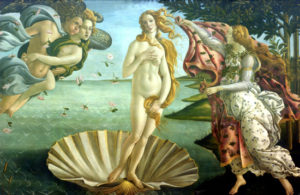
The Birth of Venus, by Sandro Botticelli, c. 1480s.
Venus was the goddess of love, sex and fertility in ancient Roman mythology; much like her Greek counterpart Aphrodite. The month of April was said to have strong associations to her, as this was the month of fertility. She was a relatively late deity who had no mention in any of the records of the early Roman period. This is supported by the lack of any festival in her honour listed in the oldest Roman calendar. However, later periods show her having two ancient temples, in Lavinium and Ardea. It is unclear how her association with Aphrodite originally began. However, a common theory attributes it to the foundation of her temple being August 19th which is the same day as a major festival of Jupiter. This connected them with a father-daughter relationship which was similar to Zeus and Aphrodite in Greek mythology. Unlike Aphrodite, Venus was also believed to be the deity of victory and prostitution.
According to mythology, Venus was born on the shores of Cypriot town Paphos. She rose from the sea foam after Saturn castrated his father Uranus and his blood fell into the sea. This links to the celebrated painting, The Birth of Venus, by Sandro Botticelli in the 15th century.
As an Italian deity, Venus had no myths of her own. However, once she became associated with Aphrodite she appropriated her mythology. As Aphrodite was linked to many other deities, this led to Venus being identified with those as well. Through this appropriation, she acquired the planet known to us as ‘Venus’. In previous mythology, the planet was originally believed to be the star of the Babylonian fertility goddess Ishtar, who then became associated with Aphrodite. This is also seen in the Aeneid which shows Aeneas being led by his mother in her celestial form as the evening star.
By the later Roman period, she was described as being involved in many romantic affairs. This in turn, led her to be associated with both the positive and negative aspects of femininity. Venus was believed to have two main divine lovers: her husband Vulcan, the god of fire and volcanoes, and Mars, the deity of war. Vulcan was believed to have trapped Venus and Mars together
while they were in bed, causing them to suffer a loveless marriage which produced no children. However, Venus was never thought of as barren as she had many children by many different male gods. Through Mars she was said to have borne Timor, the personification of fear who would accompany his father into every battle. From the messenger god Mercury, she was believed to have created Cupid who represented all aspects of love. Their union also produced Hermaphroditus, who was believed to be the beautiful personification of androgyny. Through Jupiter she was believed to have borne Fortuna who was the goddess of fate and good fortune. She is known in connection with the cornucopia, or ‘Horn of Plenty’.
While Venus was associated with many deities, she was also known to have taken mortal lovers as well. The most famous of these was Adonis and their connection with Prosperina. After accidentally grazing his mother with an arrow, she instantly fell in love with him. A popular myth recounts that she introduced Adonis to Proserpina, who also fell passionately in love with him. It was agreed by Jupiter that he would spend one third of each year with them both, and could choose what he did with the remainder of his time. He chose to spend this time above ground with Aphrodite, and as a result she neglected the shores of Paphos and her worshippers across Rome until his death.
The Homeric Hymn to Aphrodite describes Venus as the mother of Aeneas, by a Dardanian prince named Anchises. According to the Aeneid, he was guided by his mother into producing a son who would be an ancestor of the founders of Rome; Romulus and Remus. This family was known as the ‘gens Julia’, with other members of the familial branch being Julius Caesar and the later Roman Emperor Augustus Caesar.
As the deity Venus Verticordia, she became charged with the protection of chastity in women in girls. This was particularly ironic, as her existence as the deity Venus Erycina led to the erection of a temple near the Porta Collina in Rome in 181 BCE. This temple was located near to the area where a Vestal Virgin would be sent after violating terms of her chastity. It also became associated as a place of worship for Roman courtesans, linking the title “Dies Meretricum” to April 23rd, the day of its erection. This phrase translates to “Prostitutes Day”, showing that Venus was connected to all aspects of sexuality.
-Devon Allen
Junior Girl
Girl Museum Inc.
